Gas pipe service life: gas utilization standards
Gas enters the final consumer in apartments and houses through a distribution type network. Transportation is carried out through pipes for which certain GOST standards are established. The same standards establish the life of gas pipes in residential buildings for their various types.
After the expiration of the period of operation laid down by the manufacturer, the gas pipeline must be replaced. This should be monitored by specialized control services, however, it will not be superfluous for consumers to know how many pipes should be operated, how to determine the degree of their wear and the need for replacement.
The content of the article:
- What does life mean?
- Regulatory framework: what does the law say?
- What factors influence the condition of gas pipes?
- What are the signs that determine the need for replacement?
- What to do if the gas pipeline has expired?
- What to do to extend the operational life?
- How to calculate the degree of wear?
- Conclusions and useful video on the topic
What does life mean?
Life time – this is the calendar duration of the period of use of the pipelines and gas pipeline branches connected to them from the start of commissioning of the system or after its repair to the transition to the limit state. It is determined by the manufacturer gas pipeswhat is indicated in the certificate.
As such, there is no universal service life limit. In each case, it is determined individually, since one gas pipeline is operated in favorable conditions, and the other is deformed and destroyed much faster due to the influence of external factors.
Regulatory framework: what does the law say?
According to the Order of November 21, 2013 N 558, which regulates the safety rules for handling liquefied gas.

Technical inspection of the underground gas pipeline is carried out at the end of the estimated service life, which is for:
- steel pipes - 40 years;
- polyethylene pipes - 50 years.
Pipelines assembled from polymer pipes last longer due to their higher resistance to mechanical and chemical influences, as well as the absence of prerequisites for the appearance and spread of mold.
In this case, during such diagnostics, the following parameters should be checked:
- gas tightness;
- protective coating (for steel pipes);
- the state of the material from which the pipeline is made;
- quality of welding at the joints.
Early checks are carried out only in case of accidents or reliable information on the deformation of gas pipelines underground.
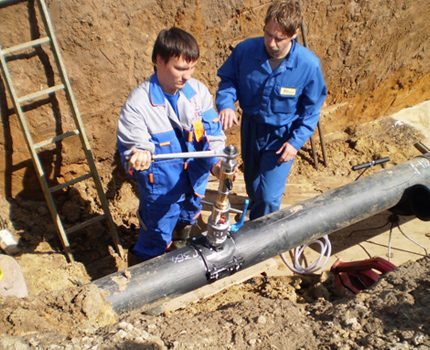
Surveys are still carried out in accordance with the instructions from RD 204 of the RSFSR 3.3-87, approved back in 1987. The provisions contained in the Decree of the Government of the Russian Federation of October 29, 2010 N 870, regarding this issue contain rather vague wordings.
So, in clause 76 it is said that the service life is determined at the time of design taking into account the conditions for ensuring the safety of facilities, the forecast regarding changes in their parameters, as well as guarantees for pipe products provided by the manufacturer.
In addition, this act refers to the fact that the gas pipeline can be operated even after the expiration of the service period if during the diagnosis no serious violations in the operation of the system and defects in the pipes were revealed. Based on the results of this diagnosis, the boundary operating periods should be re-established.
Concerning outdoor gas pipelines and equipment, then, as a rule, their service life is less. In any case, you should always pay attention to their working "experience", which is indicated by the manufacturer.
For example, the manufacturer “Gazovik” for GRPSh-6, 10, and 10MS determines the following terms:
- average (before decommissioning) - 15 years;
- Warranty term - 5 years.
But the “First Gas Company” in the passports indicates the majority of its GRPS with a 20-year period, which, incidentally, is the average for GRPS installations.
What factors influence the condition of gas pipes?
As the experience of leading expert organizations in Russia shows, underground steel pipelines retain their physical and mechanical properties even after forty years of service. Welded joints are also within regulated limits, so their service life is extended.
But this happens with respect to not all pipes, and yet not always, so you need to figure out what determines the state of pipes with the same characteristics over time.
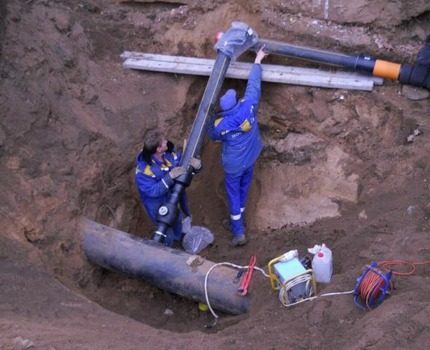
The actual condition of the pipeline and the time it reaches its ultimate state depends on:
- correct engineering decisions made at the time of design;
- good faith construction and installation work;
- the quality of materials used in the construction;
- level of soil corrosion activity;
- the effectiveness of electrochemical protection;
- monitoring;
- regularity and quality of repairs, etc.
That is why pipes released from the same plant with the same operating parameters can manifest themselves in different ways in operation over time.
What are the signs that determine the need for replacement?
The conditional normative terms of operation were indicated above. They are “divorced” from reality and are exemplary. In some cases, the gas pipeline may fail earlier, and may last much longer than the average service life of gas pipes in industrial and residential buildings, industrial facilities.
In practice, the life of a gas pipeline made of steel pipes is on average 30 years.
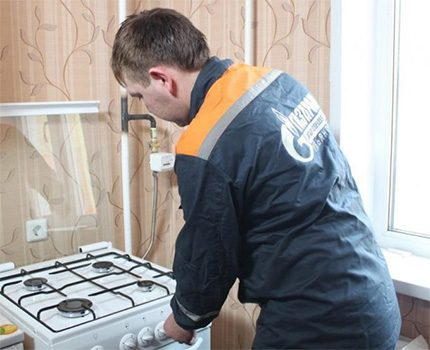
It is also worth noting that it will not be possible to determine the state of steel structures “by eye” by external signs. Public utilities must make appropriate examinations and measurements.
The signs by which it can be determined that the gas pipeline needs to be replaced by pipes are:
- thinning of the walls above normal;
- a change in the nature of joints at welding sites;
- gas leak according to meter readings.
Their results are reflected in the protocols, which the consumer is also entitled to familiarize themselves with. In addition, it may require an oral explanation of the material presented.
What to do if the gas pipeline has expired?
In the event of the expiration of the service life, their repair must be carried out, which provides for full or partial replacement of elements.
If competent persons have already completed the audit, and they concluded that replacement needed, the consumer no longer needs to do anything. Repair work should be carried out by employees of GORGAZ or other similar services serving the facility.

For a complete replacement of the gas pipeline, an exit team is sent to the site, which seizes the failed sections trunk passage to the common house pipe complex, and then looks at the situation.
Partial replacement of pipes in a multi-storey building is done by trimming old sections and placing new ones by welding.
Such events are carried out strictly in accordance with safety rules:
- The gas access to the pipes is blocked.
- From the site to be replaced, gas must be completely removed in accordance with safe handling standards for hazardous facilities.
- The old plot is cut off.
- By welding, a new element is mounted in its place.
- Checks for integrity and tightness of the site.
- Starting the gas stream through the pipe after purging them.
Repair of gas equipment cannot be carried out independently. This is a complex and dangerous process that can only be carried out by gas workers with the necessary equipment.
Moreover, the fact that such work was carried out, as well as the date of their implementation, it is necessary to enter information in the data sheet, in which all activities carried out with the system are noted. This is necessary in order to subsequently determine the life of the new gas pipeline.
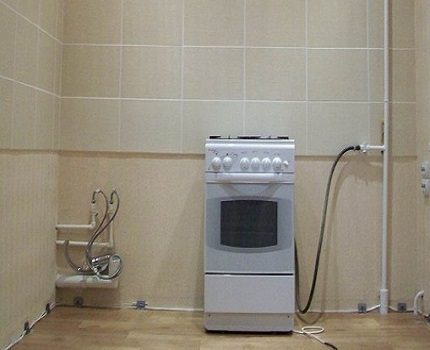
If the consumer has suspicions that the pipes have deteriorated, he can make an application to the appropriate utilities and wait for the arrival of their employees, but in no case can you verify your version without their presence.
What to do to extend the operational life?
In fact, how long the pipeline will last depends on the consumer, among other things.
To extend its life, you must systematically follow the simple rules:
- Rule # 1. Timely inspection and inspection of pipes. To do this, it is necessary to let in testers and try to be at home if the time of the check is announced in advance.
- Rule # 2. Turn on the equipment in the correct sequence. Carrying out gas system pressure testing according to the instructions and safety rules. The consumer must know which valve is responsible for what. If you are not aware of this, it is best to consult with gas workers serving your home.
- Rule # 3. Urgent check for suspected gas leak. Call the gas service immediately. They are obliged to quickly leave at the specified address. Before their arrival, it is better to close the gas valve in the apartment.
You can independently check the leak as follows: in pipe sections where the smell of gas is especially felt, anoint the suspicious place with soap suds. If bubbles begin to swell in the area, there is most likely a leak.
However, this is not a 100% leak detection method and moreover not a professional one. But for domestic use in the absence of professional equipment - it is quite suitable and, as practice shows, is quite effective.
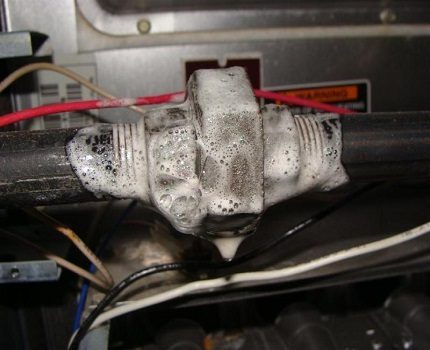
If the above says what needs to be done to extend the life and normal operation of the internal gas pipelines, then it’s said below what should not be done on the contrary:
- to tie / wind the pipes with ropes;
- reinstall equipment / change sections of the gas pipeline independently;
- Check for leaks by open flames (lighters or matches);
- deform (twist / bend) the hoses connecting the system to the plate.
These rules must be observed not only in order to extend the life of your gas pipes, but also to eliminate the risks of dangerous situations.
How to calculate the degree of wear?
For this, complex technical calculations are carried out.
Calculations are made to obtain the following characteristics:
- rated stress σs;
- SDR pipes;
- wall thickness.
After that, the minimum long-term strength MRS * of the material from which the pipe is made at a safety factor (for calculating pipelines) C.
Conclusions and useful video on the topic
For calculations, it is taken in the strength determined at a temperature of 20 ° C for a service life of 50 years according to ISO 9080:
Compliance with the deadlines stipulated by the building codes and guaranteed by the manufacturer is necessary to ensure safe operation and operation of the system. Checking the technical condition of gas supply related to the category of explosive communications, a necessary measure. It will eliminate risks and a lot of problems.
Please write comments in the block below, post a photo and ask questions about the topic of the article. Tell us about your experience in inspecting gas pipes and identifying their critical technical condition. Share useful information that may be useful to site visitors.

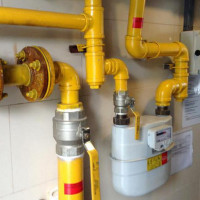 Paint for gas pipes: rules and regulations for painting inside the apartment and on the street
Paint for gas pipes: rules and regulations for painting inside the apartment and on the street  Operation of gas pipelines and equipment: calculation of residual life + regulatory requirements
Operation of gas pipelines and equipment: calculation of residual life + regulatory requirements  Standards for the distance from the gas meter to other devices: features of the arrangement of gas flow meters
Standards for the distance from the gas meter to other devices: features of the arrangement of gas flow meters 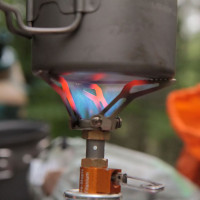 How long is the gas cylinder enough: gas flow calculation for typical gas cylinders
How long is the gas cylinder enough: gas flow calculation for typical gas cylinders 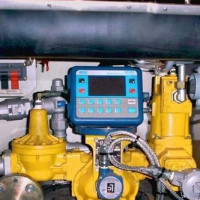 How and in what is gas flow measured: measurement methods + overview of all types of gas flow meters
How and in what is gas flow measured: measurement methods + overview of all types of gas flow meters 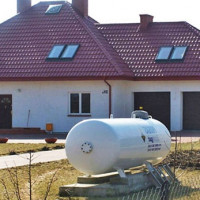 The cost of installing a gas tank in a private house: prices for gasification
The cost of installing a gas tank in a private house: prices for gasification  How much does it cost to connect gas to a private house: the price of organizing gas supply
How much does it cost to connect gas to a private house: the price of organizing gas supply  The best washing machines with dryer: model rating and customer tips
The best washing machines with dryer: model rating and customer tips  What is the color temperature of light and the nuances of choosing the temperature of the lamps to suit your needs
What is the color temperature of light and the nuances of choosing the temperature of the lamps to suit your needs  Replacement of a geyser in an apartment: replacement paperwork + basic norms and requirements
Replacement of a geyser in an apartment: replacement paperwork + basic norms and requirements